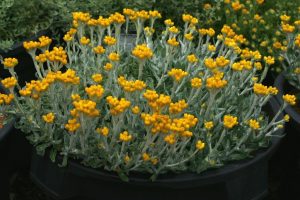Establishing a local native garden helps to encourage birds, bats, lizrds, frogs, butterflies and other insects into the garden. Enjoying the unique and precious wildlife within a garden is a genuine pleasure and a gift to the future. If you are planning a garden upgrade this year, here are four local native plants that are definitely worth considering. Look for them at your nearest native nursery or try Ben at Alexandrina Community Nursery to see if he has any in stock.
Acacia acinacea – Gold Dust Wattle
This low growing wattle is great in the garden, with softly rounded leaves, graceful stems and masses of bright golden-yellow flowers in late winter and spring.
It is fast-growing and hardy and will spread to 2m wide with open foliage. Gold Dust Wattle is frost tolerant and will grow in most soil types. It is a good background plant or a bright feature within a mixed planting.
This shrub will attract seed-eating birds to your garden.

Bursaria spinosa– Christmas Bush
This flowering bush is a really important habitat plant for insects and birds as it flowers prolifically over summer (Christmas time) when other plants aren’t necessarily doing their best.
The small white flowers are sweetly perfumed, making this shrub a lovely feature plant, and its hardiness makes it a good choice for landscape or garden use.
It is fast-growing and requires little maintenance – though a prune each year will stop it from getting leggy. It performs best in well-drained soil and will thrive in full sun to part shade.
Christmas bush is great for attracting wildlife as the dense, prickly foliage offers a protective shelter for birds and the flowers provide an important food source for butterflies and insects.

Billardiera cymosa – Sweet Apple Berry
Billardiera cymosa is a delicate, non-aggressive climber with pretty blue/purple flowers and edible fruit!
It is delightful grown over fences or embankments and can become shrub-like if grown in open situations.
This plant likes a sunny spot with well-drained soil, it is reasonably frost tolerant but can suffer in a deep frost. It will come back from the base if pruned.
The ‘Apple Berry’ fruit is sweet and delicious and can be eaten raw or cooked.

Chrysocephalum apiculatum – common everlasting
This fast-growing, low-spreading perennial will last for many years. The bright yellow flowers appear in clusters at the end of tall grey-green stems during late spring and summer.
Common everlasting is perfect for borders or adding colour to a foreground space. Trim off the spent flowerheads for best results.
This plant prefers well-drained soils and can cope with full sun. Mulch will help it thrive through summer.
Common everlasting is attractive to native butterflies and is a caterpillar plant food.



